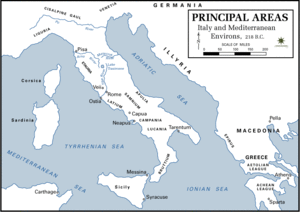Third Servile War
| Third Servile War | |||||||
|---|---|---|---|---|---|---|---|
| Part of the Roman Servile Wars | |||||||
 Italy and surrounding territory, 218 BC |
|||||||
|
|||||||
| Belligerents | |||||||
| Army of escaped slaves | Roman Republic | ||||||
| Commanders and leaders | |||||||
|
Spartacus (MIA) (Presumed killed, body never found) (Possibly Thracian - see text for alternate theory) Crixus † (Gallic) Oenomaus † (Gallic) Castus † (Gallic) Gannicus † (Gallic) |
Gaius Claudius Glaber Publius Varinius Lucius Furius Lucius Cossinius † Gnaeus Cornelius Lentulus Clodianus Lucius Gellius Publicola Gaius Cassius Longinus Gnaeus Manlius Marcus Licinius Crassus Gnaeus Pompeius Magnus Marcus Terentius Varro Lucullus Lucius Quinctius |
||||||
| Strength | |||||||
| 120,000 escaped slaves and gladiators, including non-combatants; total number of combatants unknown | 3,000+ militia 8 Roman legions of 4,000–6,000 Infantrymen + auxiliaries (32,000–48,000 Infantry + auxiliaries, total) 12,000 garrison troops, composition unknown. |
||||||
| Casualties and losses | |||||||
| 30,000 (including Crixus) killed by Lucius Gellius Publicola, 6000 crucified by Crassus, 5000 routed and crucified by Pompey, almost all others are killed or crucified | Unspecified, but heavy. 50-4,000 lost through decimation |
||||||
The Third Servile War (73–71 BC), also called the Gladiator War and the War of Spartacus by Plutarch, was the last of a series of unrelated and unsuccessful slave rebellions against the Roman Republic, known collectively as the Roman Servile Wars.
The Third Servile War, the only one of these slave revolts to directly threaten the Roman heartland of Italy, especially alarmed the Roman people due to the repeated successes of the rapidly growing band of escaped former slaves against Roman armies between 73 and 71 BC. The concentrated military effort of a single commander, Marcus Licinius Crassus, finally crushed the rebellion, though the war continued to have indirect effects on Roman politics for years to come.
Between 73 and 71 BC, a band of escaped slaves—originally a small cadre of about 78 (primarily Thracian, Gallic and Germanic escaped gladiators) which grew into a band of over 120,000 men, women and children—wandered throughout and raided Italy with relative impunity under the guidance of several leaders, including the famous gladiator-general Spartacus. The able-bodied adults of this band proved a surprisingly effective armed force that repeatedly showed that it could withstand the Roman military, from the local Campanian patrols, to the Roman militia, and to trained Roman legions under consular command. Plutarch described the actions of the slaves as an attempt by Roman slaves to escape their masters and to flee through Cisalpine Gaul, while Appian and Florus depicted the revolt as a civil war in which the slaves waged a campaign to capture the city of Rome itself.
...
Wikipedia
